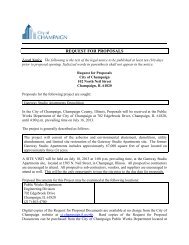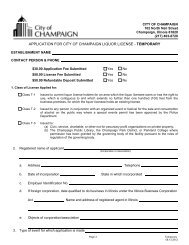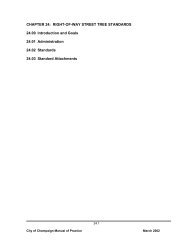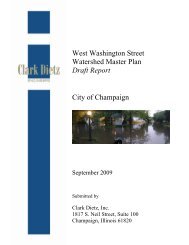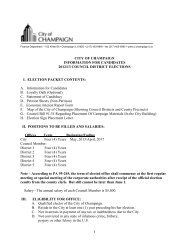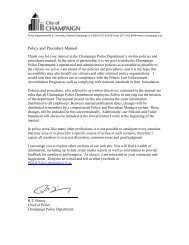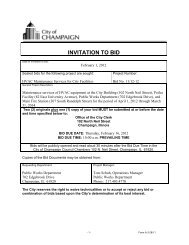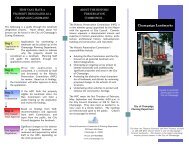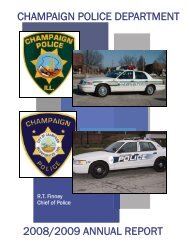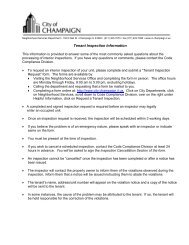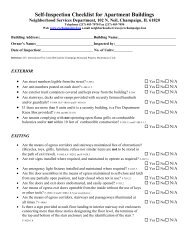2010-2014 Consolidated Plan - City of Champaign
2010-2014 Consolidated Plan - City of Champaign
2010-2014 Consolidated Plan - City of Champaign
You also want an ePaper? Increase the reach of your titles
YUMPU automatically turns print PDFs into web optimized ePapers that Google loves.
compared to the remainder <strong>of</strong> the <strong>City</strong>. Areas containing a high concentration <strong>of</strong> minority households aredepicted in the green colors on this thematic map (Exhibit 2). Areas 1, 4, 8, and 9 also contain slightlyhigher concentrations <strong>of</strong> minority households than do the remainder <strong>of</strong> the planning areas in the <strong>City</strong>. Asindicated on these two maps, the low/mod areas and the areas <strong>of</strong> higher minority concentration areclosely aligned.Population Growth and CompositionThe population in the <strong>City</strong> <strong>of</strong> <strong>Champaign</strong> has steadily increased over the past century. The <strong>City</strong>’spopulation grew most rapidly during the 1950s and 1960s with an increase <strong>of</strong> 26,281 persons between1950 and 1970. Since the 1970s, population has been growing at a slower rate, most likely attributed toslower birth rates and smaller family sizes which occurred after the “baby boom” era. The totalpopulation <strong>of</strong> the <strong>City</strong> increased by 6% between 1990 and 2000, growing from 63,502 people in 1990 to67,518 people in 2000. The population growth rate parallels the <strong>City</strong>’s geographic expansion and thegrowth <strong>of</strong> housing units. Factors contributing to the <strong>City</strong>’s population growth include the growth <strong>of</strong> theUniversity <strong>of</strong> Illinois, in-migration, annexation, and new housing development.Figure 2-1: Population by RaceNumber <strong>of</strong> People6000050000400003000020000100000W hite Black Asian Other Hispanic1990 2000Source: U.S. Census, 1990 and 2000There is a diverse mix <strong>of</strong> racial and ethnicgroups within the <strong>City</strong> <strong>of</strong> <strong>Champaign</strong>.According to the 2000 U.S. Census, the <strong>City</strong>’sracial composition is as follows: 73% white,16% black, 7% Asian, and 4% Hispanic.While the white population continues to bethe predominant racial group, its proportionhas decreased slightly for the past severaldecades. At the same time, other minoritygroups, especially Asian and Hispanic, aregrowing at a rapid pace. Between 1990 and2000, both groups have more than doubled.Age Characteristics and TrendsAge characteristics and trends are considered in the neighborhood analysis, particularly because someage groups may have unique service needs. For example, there may be a need for special programs foryouth under age 18 or seniors over age 65. In 2000, 12,011 persons in the <strong>City</strong> were under the age <strong>of</strong>18, 49,829 persons were between the ages <strong>of</strong> 18 and 64, and 5,678 were 65 and older. By 2000, 26%<strong>of</strong> the <strong>City</strong>’s population was either under 18 or over 65 years <strong>of</strong> age. Of the total population, 18% wereunder the age <strong>of</strong> 18, 8% were 65 and older, and the remaining 74% were between the ages <strong>of</strong> 18 and64.The citywide median age, averaging 24.2 years old over the past four decades, reflects the presence <strong>of</strong>the University <strong>of</strong> Illinois’ student population residing within the <strong>City</strong>. In 2000, 32% <strong>of</strong> the <strong>City</strong>’s totalpopulation was 18-24 years old. Of the 21,409 people in that age group, 73% lived in <strong>Plan</strong>ning Area 3,the University District.The <strong>City</strong>’s population <strong>of</strong> persons age 18 and under declined between 1970 and 1980, but has increasedslightly every 10 years since then. In 1990, there were 11,659 persons, or 18% <strong>of</strong> the total population,under the age <strong>of</strong> 18. Although the total number <strong>of</strong> persons under 18 in the <strong>City</strong> increased to 12,011 by2000, they continued to represent 18% <strong>of</strong> the <strong>City</strong>’s total population <strong>of</strong> 67,518.8 Housing Market Analysis



